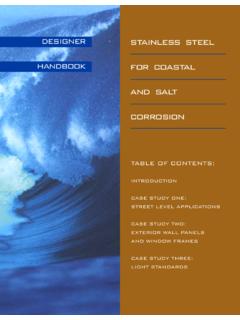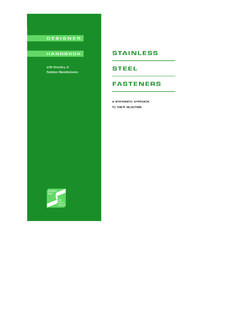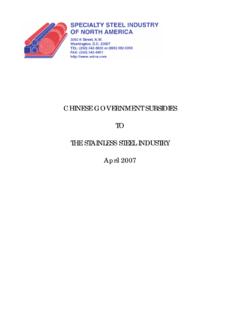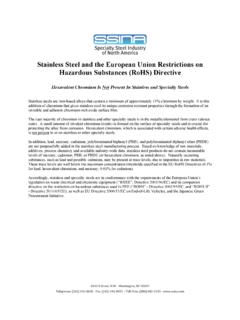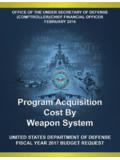Transcription of Steel and the National Defense paper - SSINA
1 Steel AND THE National Defense PREPARED: JANUARY 2007 Steel INDUSTRY ANALYSIS: IMPORTANCE OF DOMESTICALLY-PRODUCED Steel TO OVERALL National Defense OBJECTIVES AND ECONOMIC AND MILITARY SECURITY January 2007 Introduction This analysis presented by the Steel industry addresses the importance of domestically-produced Steel to our nation s overall National Defense objectives and the increased need for Steel to bolster our economic and military security. The President and other government leaders have recognized repeatedly the critical interdependence of Steel and National security. The American Steel industry and the thousands of skilled men and women who comprise its workforce produce high quality, cost-competitive Steel products for military use in applications ranging from aircraft carriers and nuclear submarines to Patriot and Stinger missiles, armor plate for tanks and field artillery pieces, as well as every major military aircraft in production today.
2 These critical applications require consistent, high quality on-shore supply sources. While leading-edge Defense applications represent only a small portion of overall domestic sales of Steel products, Defense -related materials are produced on the same equipment, using some of the same technology, and are developed by the same engineers who support the larger commercial businesses of Steel companies in the Thus, the companies are not typical Defense contractors who derive the majority of their sales and profits from their Defense business. It is the overall financial health of Steel producers, and not simply the profitability of their Defense business, that is essential to their ability to be reliable Defense suppliers. The domestic Steel industry also believes that, over an extended period of time, the United States could lose much of its Steel -related manufacturing base if Steel consumers continue to move production offshore due to market-distorting foreign government incentives and due to unsound economic policies at home.
3 If we continue to lose our manufacturing base due to market-distorting foreign competition or economic policies that are hostile to domestic investment and manufacturing, it could become impossible to produce here; the military would lose its principal source of strategic metals; and we as a nation would become dangerously dependent upon unreliable foreign sources of supply. The Steel industry, consisting of all carbon and alloy Steel producers and specialty metal producers, employs more than 160,000 highly skilled workers who produce over $60 billion of high quality Steel and high-technology specialty alloy products annually. The industry includes state-of-the-art, large and small electric arc furnace producers (or mini mills ) that make Steel from recycled scrap, and highly efficient large integrated Steel producers who make Steel from virgin materials and recycled Steel .
4 3 Steel is produced in many forms, including flat-rolled and long products, carbon pipe and tube products, wire and other fabricated products. Carbon and alloy Steel is used in all major end-use markets, including construction, automotive, machinery, appliance and containers. Specialty steels are high technology, high value materials, produced by small and medium-sized companies. These specialty metals are used in extreme environments that demand exceptional hardness, toughness, strength and resistance to heat, corrosion and abrasion, such as in the aerospace and chemical processing industries. All segments of the domestic Steel industry contribute directly or indirectly to the Defense industrial base. Criticality of the Steel Industry to the National Defense and the Defense Infrastructure The carbon/alloy and specialty Steel industries are vital partners to American Defense contractors and to the DOD.
5 Domestic and specialty metals are found in virtually every military platform. Whether it is missiles, jet aircraft, submarines, helicopters, Humvees or munitions, American-made steels and specialty metals are crucial components of military strength. A few examples follow: 1. The Joint Strike fighter F135 engine, the gears, bearings, and the body itself, will use high performance specialty steels and superalloys produced by specialty Steel companies. 2. Land based vehicles such as the Bradley Fighting Vehicle, Abrams Tank, and the family of Light Armored Vehicles use significant tonnage of Steel plate per vehicle. 3. Steel plate is used in the bodies and propulsion systems of the naval fleet. 4. The control cables on virtually all military aircraft, including fighter jets and military transport planes, are produced from Steel wire rope. Numerous additional examples illustrating how Steel and specialty metals directly support the Defense industrial base are provided in Appendices 1 and 2.
6 These materials are an integral part of many diversified military applications and, as such, are in a continuing state of technological development. Steel s importance to the military must also be looked at in a broader context to include both direct and indirect Steel shipments to the military infrastructure that are needed to support our Defense efforts, both at home and overseas -- , all of the Steel that goes into the rails, rail cars, ground vehicles, tanks, ships, military barracks, fences and bases, which are not classified as shipments to ordinance, aircraft, shipbuilding or other military uses. The September 11 attacks on the United States made it clear that (1) Steel will be needed to harden existing infrastructure and installations and (2) a strong and viable domestic Steel industry will be needed to provide immediate Steel deliveries when and where required.
7 Consider the potential difficulties the would face in defending, maintaining and rebuilding infrastructure in an environment where our nation is largely dependent upon foreign Steel . By 4becoming even more dangerously dependent upon offshore sources of Steel , the United States would experience sharply reduced security preparedness in the face of: Highly variable, and certainly higher, costs; Uncertain supply, impacted by unsettled foreign economies and politics; Quality, design and performance problems; Inventory problems, long lead times and extended construction schedules. In Appendix 3 of this paper , we illustrate how the depends upon a healthy American Steel industry to meet the growing demands for Steel -intensive infrastructure. Engineers and contractors on sophisticated infrastructure projects require an uninterrupted supply of quality Steel that they can depend upon to meet the performance characteristics of a project s design, delivered on time, and at a competitive cost.
8 National economic security requires a strong and viable domestic Steel industry to meet all of these criteria on a consistent basis. Major Economic Policy Considerations Flowing from the Criticality of Steel to National Security Economic Policies that Encourage Continued Investment in the United States If the is to maintain its strategic capability to produce Steel and other strategic metals critical to the National Defense , it must pursue economic policies that encourage continued investment in the United States in both manufacturing and technology. These policies must be based on the following assumptions: 1. multinational companies will continue to invest here if the investment playing field is relatively level because investing in the United States will be a viable, reasonably low-cost option with considerably less business risk; 2. It is not necessary or even desirable to stop investment overseas by multinational companies.
9 It is only necessary to create an environment that encourages significant, ongoing investment here; and 3. If investment continues to occur in the United States at a reasonable rate, the will maintain its manufacturing base and the competitive advantage that it currently enjoys in Steel production. There are numerous areas where we can and should ensure that domestic government policies facilitate, rather than hinder, the most efficient cost structures in the For example, we should ensure that cost factors related to energy, environmental regulations, other regulatory requirements and post-retirement benefits are not disproportionately high for manufacturers of Steel and specialty metals in the United States. In this regard, effective economic policies 5would help ensure that we have a level cost playing field. Such policies should include initiatives that would: Significantly lower energy costs for domestic manufacturers; Demand that the environmental control systems in foreign countries increase to levels comparable to those used by manufacturers; Remedy the competitive disadvantage suffered by domestic manufacturers that provide pre- and post-retirement employee benefits.
10 In addition, corporate income taxes are higher in the compared to other countries, particularly with regard to their effect on investment decisions in manufacturing. Many other economies use value-added tax (VAT) systems to encourage/subsidize their exports. Keeping Research and Development at Home Another critical area that would help ensure a strong domestic Steel industry and one capable of meeting all of the new and growing challenges in the spheres of National Defense and homeland security is to have a healthy and viable R&D effort at home. In this regard, there are important joint industry/Department of Defense (DOD) R&D initiatives that reflect recognition of the continuing importance of these materials to the National Defense . In conjunction with the DOD, for example, numerous Steel companies in the regularly participate in joint R&D activities that have led to many breakthroughs in metals technology for both military and commercial applications.

